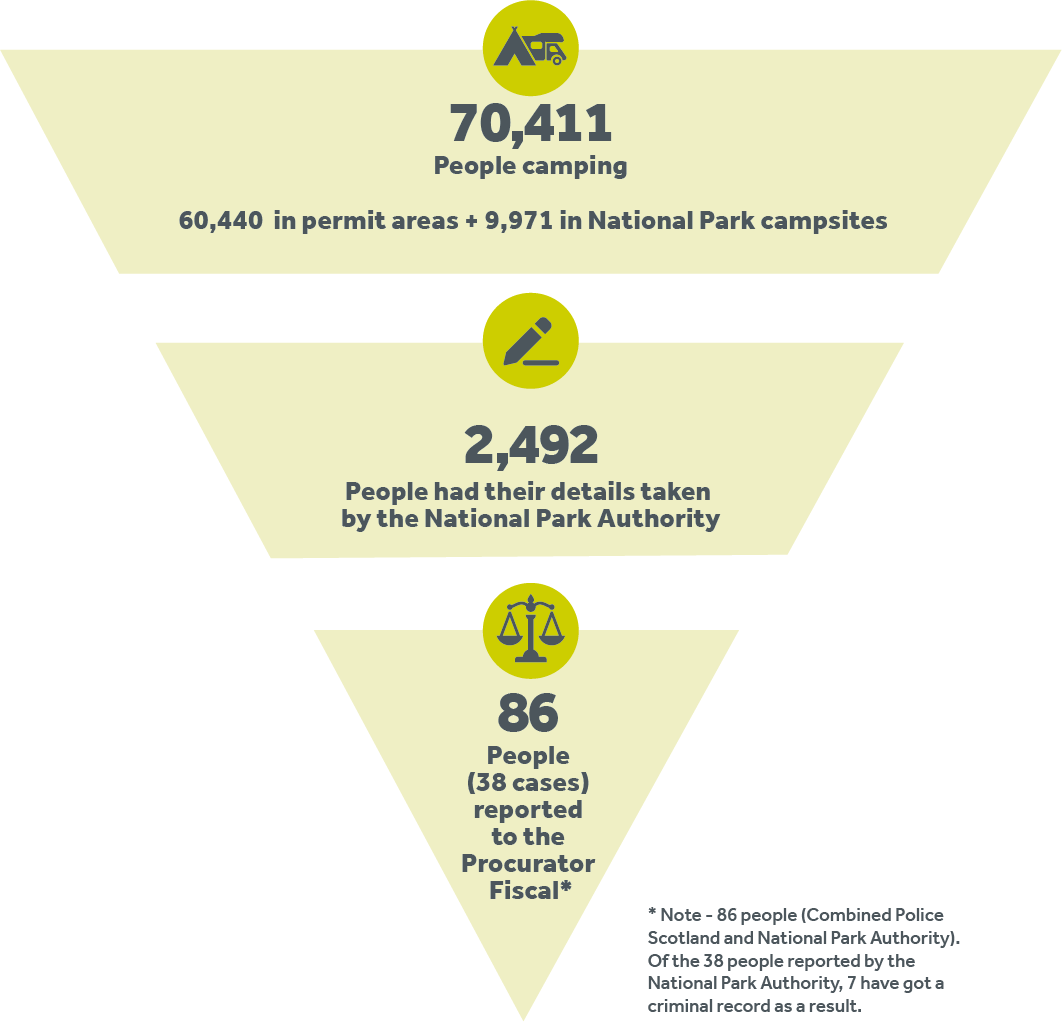
Byelaws: Three Year Report 2020
Camping is one of the most popular activities undertaken by visitors to the National Park and we are committed to providing a high quality of experience for everyone who comes to camp here.
The popularity of this activity over many years has, however, led to pressures being placed on the local environment and visitor experience both from the sheer number of people and the irresponsible behaviour of some campers.
Following a public consultation and approval by Scottish Ministers, Camping Management Byelaws were introduced in 2017 covering some of the most heavily visited lochshore areas of the National Park.
A series of measures and infrastructure improvements were brought in to support the introduction of the byelaws including engagement, education and information tools, a seasonal camping permit scheme within Camping Management Zones and the development of new, low-cost campsites within these zones.
Ministerial approval of the byelaws was accompanied by two conditions in relation to how the National Park should report on the effects of the byelaws:
- ‘Ministers should be provided with a formal report of a review of the operation of the byelaws no later than three years after implementation. The report should consider how effective the new camping management measures have been in reducing the instances of environmental damage and irresponsible behaviour as a direct result of implementation.’
- ’The National Park will ‘provide Scottish Ministers with an annual update on the implementation of the byelaws.’ We have published annual updates on the Byelaws following each camping season.
Following submission to the Scottish Government, Minister for Rural Affairs and Natural Environment, Mairi Gougeon, has endorsed the report and its recommendations.
The Report
This report looks at the impacts of byelaw implementation to date, along with the effects of the other supporting camping management measures and learnings gathered over the first three years.
This is followed by an indication of the future approach to sustainable camping management by the National Park Authority.
Key facts and figures

During the period 2017 – 2019 (inclusive):
- 70,411 people camped in the National Park.
- 60,440 camped in permit areas and 9,971 in National Park campsites.
- 2,492 people had their details taken by the National Park Authority.
- 86 people (38 cases) were reported to the Procurator Fiscal*.
*Note: 86 people (Combined Police Scotland and National Park Authority). Of the 38 people reported by the National Park Authority, 7 have got a criminal record as a result.
Key Findings
The report outlines a number of findings across a wide range of areas. Improvements in both environmental quality and camping behaviour have been seen over the three seasons so far however in some cases it is too early for data to show longer term trends.
Environmental impacts
- In most areas where camping was historically popular but is now prohibited from March to September, findings to date indicate there have been improvements in terms of vegetation and bare ground recovery. In many areas where managed camping is permitted there are slower signs of recovery, or in a few places declines in vegetation and bare ground condition.
- The overall numbers of irresponsible fire sites has been in general decline for a number of years including prior to the byelaws. Numbers of fire sites have remained relatively low in the Camping Management Zones, with slightly higher numbers in permit areas.
- Findings on litter presents a complex picture. Generally litter is being found less frequently, however when it is found, it tends to be in higher volumes than pre-byelaw era. Specifically camping-related litter was only the fourth most common type of litter found in popular camping areas over the three years.
Irresponsible behaviour
- Prior to the introduction of the byelaws there was some concern that there could be widespread disregard or deliberate contravention of them once in place, however the vast majority of campers complied with the byelaws.
- Of the total number of people that camped in a permit area or one of the new low-cost campsites over the three seasons, 2,492 (3.5%) of those who camped had their details taken in relation to an alleged contravention of the byelaws.
- During the time of the implementation of the byelaws the incidences of specific camping-related antisocial behaviour have remained low. From all available data, there is no significant change in the level of antisocial behaviour across the Camping Management Zones to date and visitors have indicated they feel safe when camping.
The report also sets out some key recommendations on how the byelaws and supporting measures will continue to be used to manage and monitor camping.

